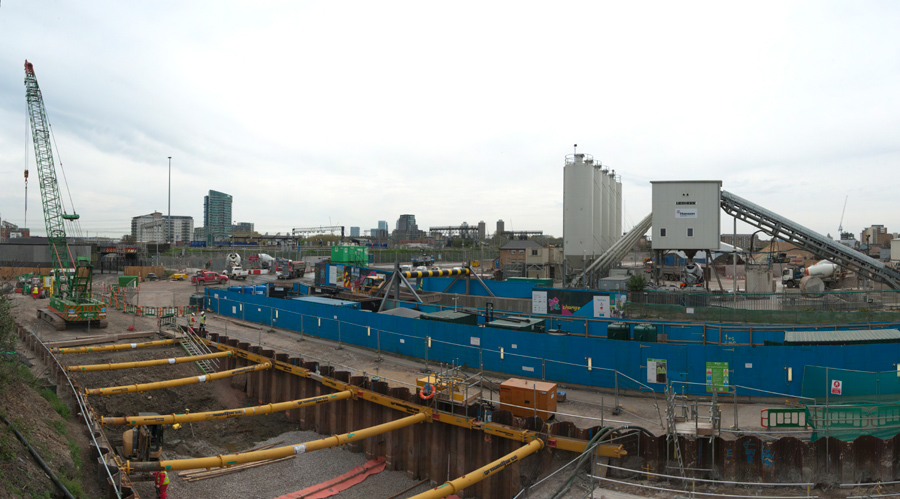After photographing the ceremony for Workers Memorial Day in Stratford, I strolled back to the View Tube on the elevated Greenway above the Northern Outfall Sewer that goes through the centre of the site and took a few pictures to show the progress on the site, as I try to do at roughly monthly intervals.
I’d come out to cover the WMD event, and had not brought a couple of the things that help to make good panoramas, but it’s still generally possible. I very seldom carry a tripod, but a monopod does a decent job and makes it much easier to take a series of pictures from the same place, but I’d left that at home.
Somewhere too, I have a short bar with a thread to screw onto the monopod, with a bolt that slides along a groove and lets you fix the camera at an offset from the centre tripod thread. Theoretically when rotating the camera to make a series of images for a panorama you should rotate the camera around the rear nodal point of the lens. You can (at least theoretically) find this by trial and error. I start at a point roughly the focal length in front of the film plane. You get your assistant to hold an object such as a pencil in front of the lens so it lines up with a distance object, and then swing the camera around. If you are rotating the camera around that nodal point the two objects will stay lined up.
It’s best to do this before you go out to take pictures, and somehow make a mark or keep a record of the distance for use on location. But since I hadn’t got it or the tripod I couldn’t do it anyway. But usually – if you avoid any close objects in the overlapped areas – you will get away without worrying about it.
Exposure is a little tricky, because as you swing the camera around the exposure reading will change – skies particularly get rather brighter near the sun on sunny days! Overcast days make panoramas easier. You also need to avoid changeable lighting. Generally its best to set the camera to manual exposure and keep it constant through the series of pictures you want to join up. On digital that means you need to start with test exposures with the camera pointing in the brightest direction and select the exposure which just avoids highlight clipping by inspecting the histogram.
The third thing I hadn’t brought was the fixed lens I like to make panoramas with. It is important not to change image scale when taking a series of exposures, and that is only too easy with most zooms. Its best to turn off autofocus too, and rely on manual focus, and the easiest way to do this is with a lens with a depth of field scale. Zoom lenses either don’t have these or they are useless.
I find the 20mm F2.8 Nikkor is a decent lens for panoramas. Used in landscape format (which is easier) it gives a decent vertical field of view on full frame. Prime lenses also generally have less distortion than zooms, which makes stitching frames easier. The DOF scale tells me that when set at 2m, everything from around 1m almost to infinity will be sharp at f5.6. Of course I don’t believe it, as DOF scales are always calculated for rather small prints, but stop down to f8 and things should be ok.
Anyway, these pans were made with the Nikon 16-35mm set to 24mm and typical exposures of 1/25 fll. All were handheld, and almost all worked pretty well. Here I can only show them very small, and even on My London Diary they are only 900 pixels wide, while the originals are mainly 7-14,000 pixels wide.

360 degrees on the Greenway. Original ca 14,000 pixels wide
Of course the lighting was a little changeable, which led to a few frames with clipped highlights, and in one set of images I’d moved the camera just too much from its original position – so the images almost but not quite join.

Most were made with the camera in vertical (portrait) format, and were joined using PTGui and use the equirectangular projection. The one above was made from three overlapping vertical images.
You can see seven more (including the one that doesn’t quite join up properly) as well as some single images I took on my walk – which took me along the Greenway, then through Three Mills to to the Limehouse Cut and Langdon Park DLR station on My London Diary.